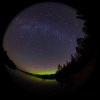Lens selection is part of the problem - but it's quite feasible to use a 50/1.8. It doesn't even matter if your fastest lens is f/2.8. Here's how...
Apart from the most astrophotography, there's no real reason to limit yourself to ultrawide lenses or short exposures. It's quite possible to use easily run 5 minute exposures with a 200 mm lens if you're willing to construct a "barn door tracker."
Basically, the tracker is two pieces of wood connected with a hinge. A screwed rod and an elastic band connect the pieces of wood - one pulls and the other pushes. Now you point the hinge at the north celestial pole (which is located very close to Polaris) and push using the screwed rod. Here's a really good design...
http://www.garyseronik.com/?q=node/52 .
Note that this model has a ball head for the camera (so you can point it anywhere) and another ball head (to allow the hinge to be aligned with the earth's rotation.) If you have one, a Manfrotto or Arca-Swiss Cube are better choices for mounting the lower plate but there are far less expensive solutions.
If you do get into using a tracker, it's quite feasible to record galaxies - the Magellanic clouds, M31/M101 and M33 are easy. This does require a measure of sophistication in your image processing - in particular you need to learn about minimising camera noise. This is a good reference
http://astropix.com/ but I recommend you buy Jerry's e-books.
Ok - on the Zeiss 25/2
I have one of these. It's an expensive piece of glass. It's also probably the sharpest lens of it's type available. It is certainly sharper than the 21/2.8. Be aware that the 24L has considerable focus curvature. The Zeiss has some but it's better controlled. If you're after the very best possible, the Zeiss 50/2 MP and 135/2 are beyond compare in the SLR business. Both are quite capable of resolving stars to a couple of pixels over the entire frame. It is extremely difficult to focus with sufficient accuracy - magnified live view is the only way and since temperature can swing things around, you're silly if you rely on the lens' hard stop.
Finally - the obligatory plug. If you're interested in astrophotography with a camera, why not join the Canon DSLR Digital Astrophotography group on Yahoo! We have nearly 2900 members (not all of whom are active)
http://tech.groups.yahoo.com/group/Canon_DSLR_Digital_Astro/
Full disclosure - I'm one of the moderators.



